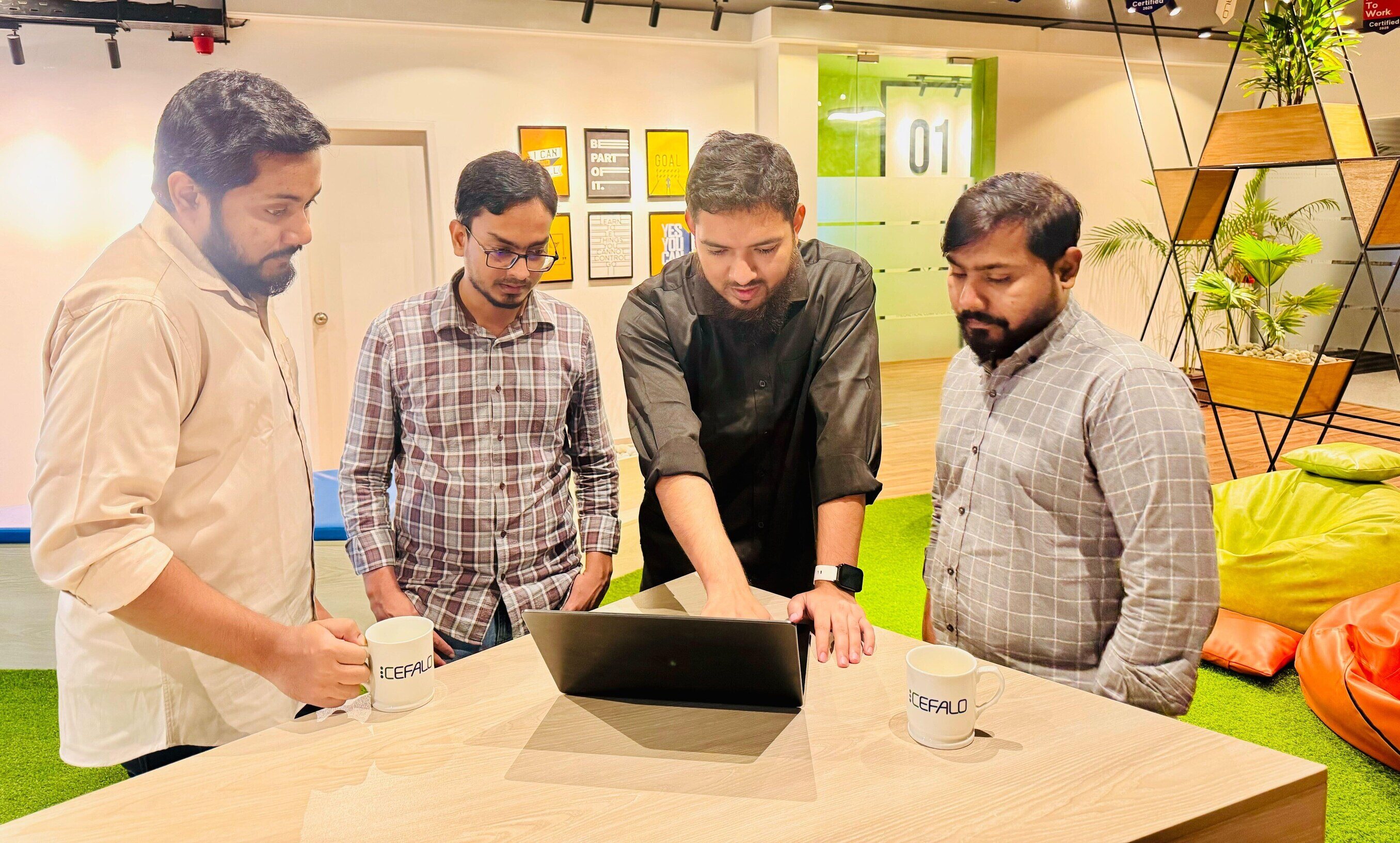
GET YOUR OWN CEFALO TEAM: In Dhaka, we have 250 employees working full-time for Norwegian clients. In many ways, we operate like a recruitment agency – helping you hire skilled developers in permanent positions.
What is an Offshore Development Team?
An offshore development team is a team of IT developers located in a different country. Cefalo's developers are based in Dhaka, Bangladesh. Nevertheless, the offshore teams become an integrated part of the Norwegian company they work for. They are led directly by the Norwegian client, without any intermediaries.
The goal is for the offshore developers to feel like permanent employees. They do not work on a project basis but in dedicated full-time positions. This way, an offshore development team differs from classical outsourcing, where the customer typically gets help with a specific project-based development need with an end product. The end product could, for example, be an app or a website. With classic project-based outsourcing, the customer pays for the end product, not for the developers' hours.
With an offshore development team, a team of at least two developers is recruited, and tailored to the customer's needs. The developers become part of the customer's development team. This provides stability and a long-term vision for the project, for both the developers and the Norwegian client. The stability ensures the same quality and progression as if the developers were sitting in an office in Norway.
Getting Started
Could an offshore development team be right for you and your company? If so, contact us to get acquainted and learn more about how we work.
The collaboration with Cefalo, as a provider of offshore development teams, begins with meetings where we get to know each other and assess needs. In these meetings, we examine whether an offshore development team is the right solution for addressing the needs of the Norwegian client.
In the initial meetings, we assess:
- The timeframe you envision
- The expertise and skills you need
- The number of developers needed
- The team composition you need
- How the collaboration will be between the Norwegian team and the offshore team
The process works as follows: When you need IT developers, we list and promote the positions you need. We then conduct the recruitment process, which takes approximately 3-4 months.
We don't have developers waiting on the bench; we actively go out and find the resources you need. This way, you get exactly the competence you need without spending time on recruitment. The recruitment process is free of charge.
We find developers through two channels: online ads via Bdjobs.com (Bangladesh's largest recruitment portal) and by utilizing the networks of our employees in Dhaka. We then select the best candidates through a comprehensive verification process.
Once we've found the right candidates, we recommend dedicating a week to meetings and team-building at your Norwegian premises. This way, the external developers become an integrated part of your company and the Norwegian team they will be working with.

WE FIND DEVELOPERS THAT FIT YOUR NEEDS: Cefalo has access to top-tier developers in Dhaka and selects those who match your specific requirements.
How Does Daily Collaboration with the Team Work?
Once the developers are in place, they work directly for you, just like your regular employees. The main difference is that they are located in Dhaka, Bangladesh. The offshore developers are directly led by you, without any intermediary or project manager in Norway. By eliminating the intermediary, a bond and sense of belonging is created between the team in Norway and the team in Bangladesh. This, in turn, provides identity to the team and stability in deliveries.
To succeed in the collaboration, the offshore developers must become an integral part of your company and be perceived as regular employees. The more you invest in the collaboration, the more you'll gain in return.
For ongoing collaboration to work, clear expectations from both parties, established routines and structure, and the use of an agile methodology, such as Scrum, are essential. Regular video meetings are also crucial for efficient communication, avoiding misunderstandings, and establishing a clear distribution of responsibilities. This will contribute to good progress and a more self-sufficient team.
– Cefalo enables us to grow and experiment, says Petter Hagman, Head of Development at DN Media Group. They weren't just looking for a cost-effective solution; they wanted senior expertise quickly so the company could scale.
COULDN’T HAVE GROWN THIS MUCH WITHOUT CEFALO: Petter Hagman shares what it’s like to be a Cefalo client.
Who Is an Offshore Development Team Suitable For?
Offshore development teams work well for Norwegian companies with ambitions to grow, who already have local developers and local development management. Software development should be a core function of the company. The company often needs more staff but struggles to find developers in Norway.
With an offshore development team, you, as the customer, are responsible for leading the development work. Dialogue occurs directly with the developers without any intermediary. In this way, offshore development teams are much like recruitment. The Norwegian company gets a dedicated team that feels like regular employees, and they pay for the hours worked, not for the result or product of the work.
Benefits of Offshore Development Teams
With offshore development teams, you get:
In the IT nation of Bangladesh, we have access to a large market of highly skilled developers. Cefalo is a highly ranked workplace in Bangladesh and attracts many of the most talented developers.
Flexible solution. You can scale your team up or down as needed. With Norwegian developers, there is a significant commitment, but with an offshore development team, it's easier to adjust the need for more or fewer developers as your requirements change.
Cost-effective. The cost of a skilled senior developer from Bangladesh is nearly half the price of a Norwegian developer of the same quality.
Time-saving. The offshore development team will be in place within 3-4 months. A recruitment process in Norway typically involves significantly more time and money.
What Does It Cost?
Bangladesh is an IT nation with many skilled IT developers. Labor costs are much lower in Bangladesh than in Norway, and the availability of developers is much larger. Based on this, you can get external development teams for nearly half the price of Norwegian developers. With an external development team, you simply get more development for the same development budget.
With Cefalo, you get senior developers for 52,500 NOK per month. A full-time senior developer in Norway typically costs around 800,000-900,000 Norwegian kroner per year in salary alone (and significantly more if you add employer contributions, vacation pay, office space, and various other direct and indirect costs). Not to mention hiring a Norwegian developer on a consultancy basis, which can cost well over 1,000 Norwegian kroner per hour, even in long-term agreements.
How to Succeed with an Offshore Development Team?
To succeed with an offshore development team, it's essential to be present to motivate and lead your team. The location of the team is not particularly important, as long as the work is done under efficient distance management.
Here are our 11 tips for success:
-
- Have daily video meetings.
- Be clear and present.
- Build trust and confidence.
- Have frequent small deliverables.
- Evaluate and provide feedback.
- Celebrate all victories, big and small.
- Eliminate "us" and "them" mentality.
- Use a local team lead.
- Use the right tools.
- Reframe the time difference from an obstacle into an opportunity.
- Be aware cultural differences.
Learn more about succeeding with an offshore development team.
How to Succeed with Remote Management of Developers
We’ve been leading external development teams for nearly 15 years. This article shares our best tips and insights.

Who is Cefalo?
Cefalo is a Norwegian company specializing in the recruitment and long-term leasing of full-time developers to the Norwegian market. We have a fully Norwegian-owned subsidiary in Dhaka, Bangladesh, where our developers work. The Dhaka office is considered one of the best workplaces in Bangladesh, and we consistently receive high scores in employee surveys. Satisfied employees contribute to low turnover, which is one of the reasons for Cefalo's success. We have over 200 employees, and we are continuously growing.
The culture and working conditions are inspired by Norwegian work culture, with a focus on technology, knowledge-sharing, and a positive work environment. We strive to deliver the best development teams while creating the most attractive workplace in Bangladesh. To achieve this, we emphasize:
- Flat structure
- Trust-based leadership
- Transparent communication
- Focus on work/life balance
- HR and personnel functions
- Competitive salaries
- Continuous education
- Perks such as lunch arrangements and a chef
- Team-building and social activities
- Various employee benefits and annual trips where their families are welcome to join.





.png)

